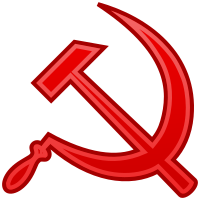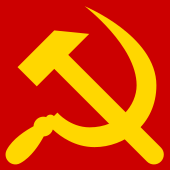I think it looks suspiciously like a Communist plot...LOL
Here is background on Hammer and Sickle--lots of background, this was one of the major iconic images of the Twentieth Century after all...
| This article needs additional citations for verification. (January 2013) |
Contents |
Historical Usage in Communism

The Plough flag from 1914 and flown during the Easter Rising.
Later, the hammer and sickle symbol was featured on the flag of the Soviet Union, adopted in 1923 and finalized in the 1924 Soviet Constitution, and flags of the republics of the Soviet Union after 1924. Before this, the flags of Soviet republics tended to be a plain red field, with the golden text of the name of the respective republic superimposed on it, as written in Article 6 of the 1918 Soviet Constitution.
- The Coat of Arms of the Soviet Union and the Coats of Arms of the Soviet Republics showed the hammer and sickle, which also appeared on the Red Star badge on the uniform cap of the Red Army uniform and in many other places.
- Serp i Mólot (transliteration of Russian: Серп и молот, "Sickle and hammer") is the name of the Moscow Metallurgical Plant.
- Serp i Molot is also the name of a stop on the electric railway line from Kurski railway station in Moscow to Gorky, featured in Venedikt Erofeev's novel, Moscow-Petushki.
Current usage
| This section requires expansion. (June 2013) |
Two federal subjects of the post-Soviet Russian Federation use the hammer and sickle in their symbols: the Vladimir Oblast has them on its flag and the Bryansk Oblast has them on its coat of arms, which is also the central element of its flag. In addition, the Russian city of Oryol also uses the hammer and sickle on its flag.
The former Soviet (now Russian) national airline, Aeroflot, continues to use the hammer and sickle in its symbol.
The separatist government of Transnistria uses (with minor modifications) the flag and the emblem of the former Moldavian SSR, which include the hammer and sickle. The flag can also be used without the hammer and sickle in some circumstances, for example on Transnistrian-issued license plates.
The Communist Party of China uses it as the party symbol. It is also used by Communist Parties in most countries.
The Maoist group, Shining Path in Peru uses it as part of its symbol.
A hammer and a sickle are both prominently included in the Austrian coat of arms, although they are not superimposed over each other and are not intended to represent communism, rather the union of the workers and the former aristocracy (represented by a crown) within the Austrian Republic.
The sound of the hammer and sickle clashing was heard in the background of the Soviet National Anthem when sung with lyrics, it is perhaps most noticeable in the version sung by The Red Army Choir - listen here: http://www.youtube.com/watch?gl=GB&hl=en-GB&v=kVdVTVR-j0Q. It was said to represent the sweat and toil of the people who lead the country to communism.
Variations of the symbol

4th International symbol with number 4 superimposed.
Tools represented in other designs include: the brush, sickle, and hammer of the Workers' Party of Korea; the spade, flaming torch, and hoe used prior to 1984 by the British Labour Party (which was a socialist and not a communist party); the monkey wrench and tomahawk of the Earth First! movement; the pickaxe and rifle used in communist Albania; and the hammer and compasses of the emblem of the East German flag. The Far Eastern Republic of Russia used an anchor crossed over a spade or pickaxe, symbolising the union of the fishermen and miners. The Fourth International, founded by Trotsky, uses a hammer and sickle symbol on which the number '4' is superimposed. The hammer and sickle in the Fourth International symbol are the opposite of other hammer and sickle symbols in that the head of the hammer is on the right side and the sickle end tip on the left. The Trotskyist League for the Fifth International merges a hammer with the number '5', using the number's lower arch to form the sickle.
The Communist Party of Britain uses the hammer and dove symbol. Designed in 1988 by Mikhal Boncza, it is intended to highlight the party's connection to the peace movement. It is usually used in conjunction with the hammer and sickle, and appears on all of the CPB's publications. Some members of the CPB prefer one symbol over the other, although the party's 1994 congress reaffirmed the hammer and dove's position as the official emblem of the Party. Similarly, the Communist Party of Israel uses a dove over the hammer and sickle as its symbol. The flag of the Communist Party of Guadeloupe uses a sickle, turned to look like a majuscule 'G', to represent Guadeloupe.[1]
With differing intent, the eagle on the Austrian flag holds a golden hammer in its left talon, and a golden sickle in its right talon. The tools were not meant to be references to communism (indeed, the eagle also wears a golden crown) but, rather, were meant to represent the industrial and agricultural laborers, united with the former aristocracy, in one republican democracy.
The flag of the Black Front, founded by Otto Strasser, featured a crossed hammer and sword, symbolizing the unity of the workers and military.
The flag of Burma, from 1974–2010, featured a bushel of rice superimposed on a cogwheel.
The flag of (CCM) Chama cha Mapinduzi (Party of the Revolution in Swahili)- currently the ruling political party of Tanzania - has a slightly different symbol with a hammer and a hoe/jembe instead of a sickle to represent the most common farm tool in Africa.
Unicode
In Unicode, the "hammer and sickle" symbol is U+262D (☭).Controversy and legal status
See also: Red star#Legal status
The hammer and sickle remain a popular symbol among communists and certain other leftists
worldwide. In most countries, there are no laws restricting the use of
the symbol, so it is legal to display it publicly. This includes the
majority of European countries, especially Western Europe. Two nightclubs in Austin, TX (Molotov [2] and Red7[3]) include the hammer and sickle in their logo.However, in several countries in Eastern Europe, there are laws that define the hammer and sickle as the symbol of a "totalitarian and criminal ideology", and the public display of the hammer and sickle and other communist symbols such as the red star is considered a criminal offence. Hungary,[4] Lithuania,[5] and Moldova (October 1, 2012 - June 4, 2013)[6] have banned the symbol along with other communist symbols. A similar law was considered in Estonia, but eventually failed in a parliamentary committee. The foreign ministers of Lithuania, Latvia, Bulgaria, Hungary, Romania and the Czech Republic called for an EU-wide ban on communist symbols in 2010, urging the EU "to criminalize the approval, denial or belittling of communist crimes" and stating that "the denial of such crimes should be treated the same way as the denial of the Holocaust and must be banned by law".[7]







No comments:
Post a Comment
Please leave a comment-- or suggestions, particularly of topics and places you'd like to see covered